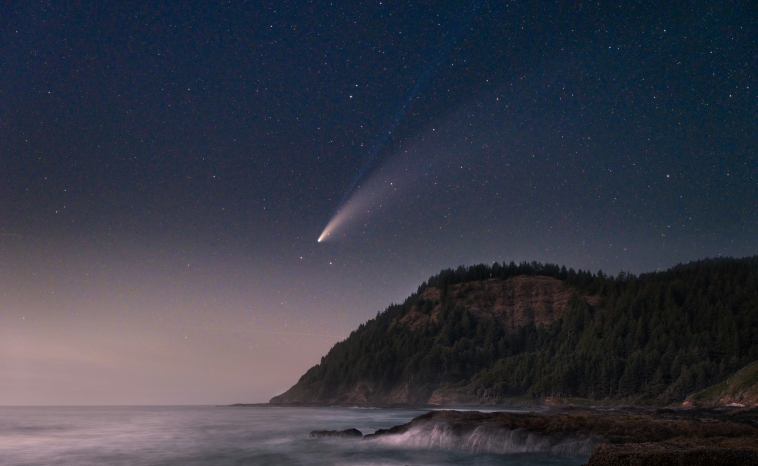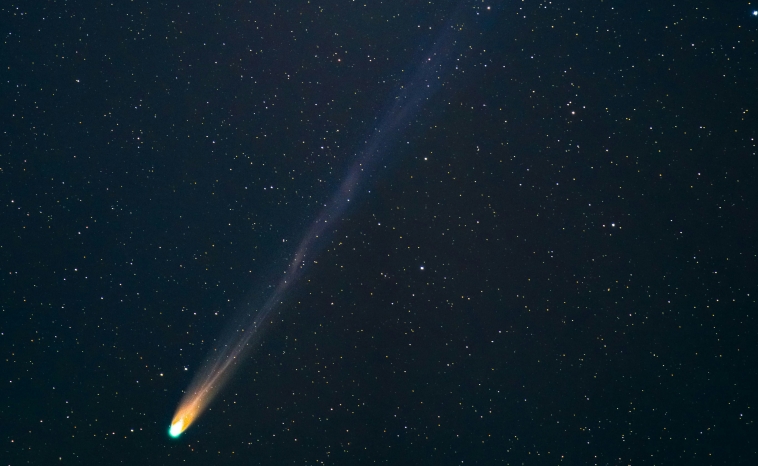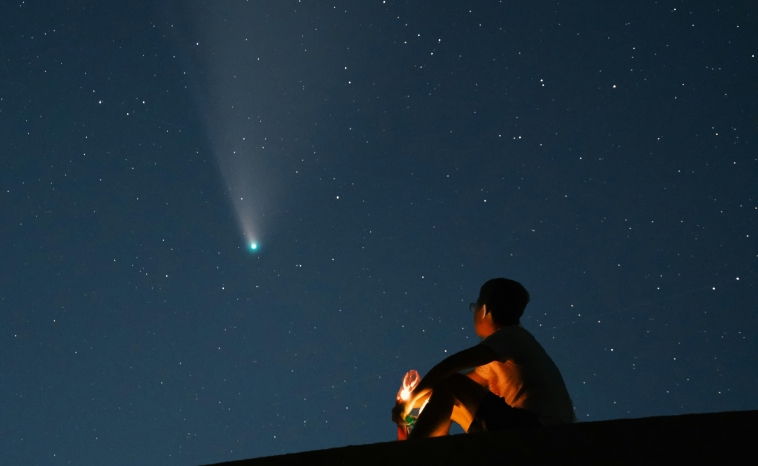What Are Comets?

In this guide, we’ll tell you everything you need to know about comets, including what they’re made of, where they come from, and famous comets that have visited our night skies.
The night sky is always a magical thing to enjoy. But every now and then, we’re lucky enough to enjoy the presence of an extra special visitor gracing our view – a comet! These celestial objects have been captivating us for centuries with their unique appearance and unpredictable behaviour. But what are comets exactly?
In this guide, we’ll tell you everything you need to know about these frosty visitors from afar. We’ll explore their structure and formation, share some observation tips, and even take a peek at some of the most famous comets that have visited us. We’ll also take a sneak peek at an upcoming celestial visitor that might just make an extra special appearance later this year, Comet C/2023 A3.
What Is a Comet?

Comets, often called the “dirty snowballs” of space, are more than just a curious sight in the night sky. These icy bodies hold secrets that tell the story of our solar system’s formation and evolution. For astronomy enthusiasts, science students, and the general public, understanding comets can provide profound insights into the history of our cosmic neighbourhood.
Comets are small celestial bodies composed primarily of ice, dust, and rocky material. When they approach the Sun, they heat up and release gases and dust, creating a glowing coma and sometimes a tail that can stretch for millions of kilometres. This makes comets one of the most beautiful and intriguing objects in our solar system.
What Are Comets Made Of?

To truly appreciate comets, we must first understand their anatomy. Comets consist of three main components:
The Nucleus
At the heart of every comet lies its nucleus, a solid core made of ice and rock. This nucleus is typically only a few kilometres in diameter but serves as the comet’s powerhouse. The nucleus contains frozen water, carbon dioxide, methane, ammonia, and other volatile compounds. These materials are remnants from the early solar system, making comets valuable time capsules.
The Coma
When a comet ventures close to the Sun, the heat causes its ice to vaporise, forming a glowing cloud of gas and dust around the nucleus. This cloud, known as the coma, can grow to be thousands of kilometres wide. The solar wind and radiation pressure push the coma away from the Sun, creating the iconic tails of comets.
The Tails
Comets are famous for their spectacular tails, which can be divided into two types:
- Ion Tail: This tail consists of charged particles (ions) pushed away from the coma by the solar wind. It always points directly away from the Sun.
- Dust Tail: Made up of larger particles, the dust tail is shaped by the pressure of sunlight. Unlike the ion tail, it often curves and can be seen as a broad, diffuse trail.
Understanding these components helps us appreciate the dynamic and changing nature of comets as they travel through the solar system.
How Do Comets Form?
Comet formation is a story of cosmic wanderers hailing from the outer reaches of our solar system. In fact, comets primarily originate from two regions:
The Oort Cloud
The Oort Cloud is a vast, spherical shell of icy objects that surrounds our solar system at a distance of up to 100,000 astronomical units (AU) from the Sun. It is thought to contain trillions of comets. Occasionally, gravitational interactions with nearby stars or passing celestial objects can send comets from the Oort Cloud spiralling into the inner solar system.
The Kuiper Belt
Closer to home, the Kuiper Belt is a region beyond Neptune’s orbit, extending from about 30 to 55 AU from the Sun. This disk-shaped zone is populated with icy bodies, including many short-period comets. These comets have orbits that bring them into the inner solar system more frequently than their Oort Cloud counterparts.
Once a comet is nudged from its distant home, it begins its long, elliptical journey around the Sun. As it approaches the Sun, the intense heat causes the ice within the nucleus to vaporise, creating the coma and tails that make comets such a dazzling spectacle. This process can take thousands or even millions of years.
How to Observe Comets

For amateur astronomers, observing comets is a thrilling and accessible way to explore the cosmos. Here are some tips to help you get started!
Best Times to Observe Comets
Timing is crucial when it comes to comet observation. The best time to observe comets is when they are closest to the Earth and the Sun, known as perihelion. This is when they are most active and brightest. Keep an eye on astronomical calendars and websites for information on upcoming comet appearances.
Essential Tools for Viewing Comets
While you can sometimes see comets with the naked eye, having the right tools can enhance your experience:
- Binoculars: A good pair of binoculars can help you spot comets and observe details in the coma and tails.
- Telescope: For a closer look, a telescope with moderate magnification is ideal. It allows you to see the nucleus and finer structures.
- Star Charts and Apps: Use star charts and astronomy apps to locate comets accurately. These resources provide real-time information on comet positions.
Patience and dark skies are your best allies when observing comets. Find a location away from city lights to reduce light pollution. Allow your eyes to adjust to the darkness, and take your time scanning the sky. Comets can appear as faint, fuzzy patches, so don’t expect them to look like bright stars!
Famous Comets in History

CREDIT: Myrabella, Public domain, via Wikimedia Commons
CREDIT: Myrabella, Public domain, via Wikimedia CommonsThroughout recorded history, comets have long been a source of fascination for our species. Here are some of the most famous comets that have graced our skies:
Halley’s Comet
Perhaps the most famous of all, Halley’s Comet, returns to our inner solar system approximately every 76 years. It was last visible in 1986 and will make its next appearance in 2061. Stargazers have observed and documented Halley’s Comet for over two millennia, making it a familiar visitor that has inspired civilisations throughout history.
Comet Hale-Bopp
Discovered in 1995, Comet Hale-Bopp became one of the brightest comets of the 20th century. Its spectacular display captivated observers worldwide for over 18 months. The comet’s long visibility and stunning appearance left an enduring legacy in the world of astronomy.
Comet Shoemaker-Levy 9
In 1994, Comet Shoemaker-Levy 9 made headlines when it collided with Jupiter. This event provided a rare opportunity for scientists to study the impact of a comet on a planet. The collision left visible scars on Jupiter’s atmosphere, offering valuable insights into planetary dynamics.
C/2020 F3 (NEOWISE)
Discovered in March 2020, Comet NEOWISE dazzled skywatchers with its brilliant display during the summer months. It became one of the most memorable comets of the 21st century. NEOWISE’s bright nucleus and long, golden tail were visible to the naked eye, providing a rare treat for both amateur and professional astronomers.
What Is the Next Comet We Might See?
Excitement is building among astronomers and stargazers as we anticipate the arrival of Comet C/2023 A3 (Tsuchinshan-ATLAS). Expected to make its closest approach to the Sun in October 2024, this comet promises to be a spectacular sight.
Comet C/2023 A3 was discovered independently by astronomers at the Tsuchinshan (Purple Mountain) Observatory in China and the ATLAS (Asteroid Terrestrial-impact Last Alert System) project. Its discovery has generated considerable interest due to its potential brightness and visibility. While some initial estimates have suggested the comet could reach an apparent magnitude of -4 (about as bright as Venus), recent observations indicate that it could now reach around +0.4 – which would still be a lot brighter than Comet NEOWISE, which was highly visible on Earth in 2020.
Astronomers anticipate Comet C/2023 A3 to develop a bright coma and potentially a long tail as it approaches the Sun. All being well, it could become visible to the naked eye in the weeks leading up to its perihelion, leaving stargazers around the world eagerly awaiting its arrival.
Star Finder App

More than just beautiful celestial objects, comets are cosmic storytellers, revealing the history and evolution of our solar system. From their icy nuclei to their glowing comas and majestic tails, comets offer a glimpse into the mysteries of the universe.
Exploring comets can be both educational and awe-inspiring. By understanding their structure, formation, and observation techniques, you can deepen your appreciation for these celestial wanderers.
To make the most of the upcoming visit of Comet C/2023 A3 and other wonders of the night sky, download the OSR Star Finder App. This intuitive and informative tool will guide you through the constellations, planets, and other astronomical phenomena. Don’t miss out on this stellar experience—download the OSR Star Finder App and start your journey among the stars today!

